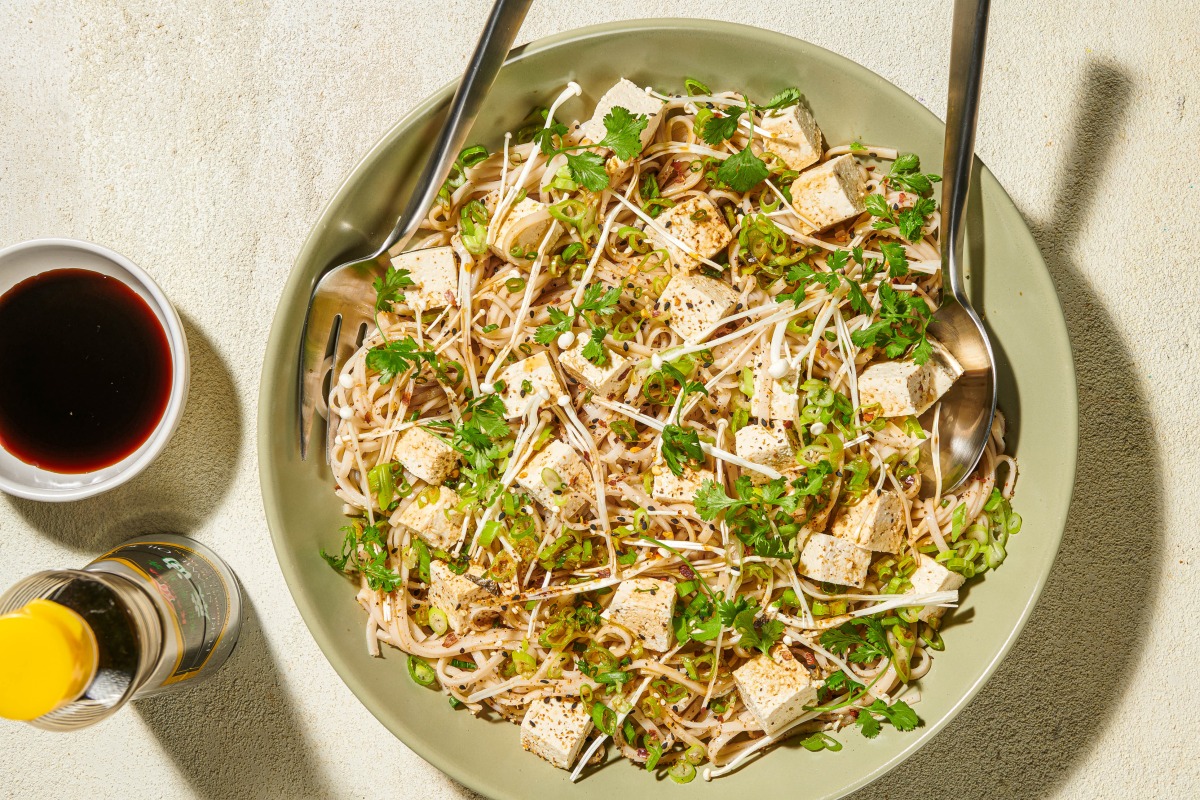In college, I majored in culinary history and anthropology, and I recall that in one of my introductory courses, the professor assigned us everyone to write a brief essay on a dish that was “pure flavor.” I can’t recall what I chose, but I only received a passing mark for it. The student with the best grade wrote an essay about tea.
According to the Food and Agriculture Organization of the United Nations, there are thousands of different types of tea, and it is the second most consumed beverage worldwide after water.
Tea is also a social drink, and it’s how I met my friend Robert Wemischner. We met, if I remember correctly, at a tea tasting class in Los Angeles. Wemischner is a culinary school instructor, tea expert and the author, with Diana Rosen, of “Cooking With Tea: Techniques and recipes for Appetizers, Entrees, Desserts, and More.” Today’s recipe, for Cold Tea Noodles, is from their book, and it’s an astonishingly flavorful and remarkably simple summer meal.
It starts with green tea, which you’ll brew and then use to cook udon noodles. Wemischner says genmaicha, a grassy green tea with bits of toasted sticky rice, is his favorite tea to use here. (But he offered some suggested substitutions, below.)
“Forward, grassy, verdant and fresh, it even has a bit of a marine or saline thing going on,” is how he described genmaicha. “I like that because I think there’s umami there, and that flavor makes us want the next bite. You’re not going to be bored with a full serving of this flavor. There’s nothing mononote or monotone about it.”
After you brew the tea and cook the noodles – they take just a few minutes to become tender – your cooking work is done. Wemischner recommends doing this the night before, so the noodles are ready for lunch or dinner the next day, when you’ll top them with tender enoki mushrooms, scallions and perky sprigs of cilantro. Season each bowl with light soy sauce – not the same as low-sodium soy sauce – sesame oil, and togarashi (preferably shichimi, though ichimi also works) or other pepper flakes before serving.
“You can use lots of different types of tea here,” Wemischner says, “but I love the haunting, memorable flavor of green teas with udon and tofu.”
– – –
Cold Tea Noodles
Active time: 15 minutes | Total time: 30 minutes, plus chilling time
2 servings
Udon noodles cooked in freshly brewed genmaicha tea, and then chilled, are the base of this hot-weather meal. Adapted from “Cooking With Tea” by Robert Wemischner and Diana Rosen, it’s an ideal make-ahead lunch or dinner. As the noodles steep in the tea while they cool, they pick up its grassy flavor, which goes especially well with tofu, mushrooms, scallions and cilantro. Season each bowl with light soy sauce – which is different from low-sodium soy sauce – sesame oil, and togarashi (preferably shichimi, though ichimi also works) or other pepper flakes before serving.
If you don’t have green tea, you can use English breakfast, Assam, or a Chinese or Indian black tea. You can also use broth (mushroom or spring onion might be nice) or water, though the flavor of the noodles will not be the same.
No udon? Linguine works in a pinch.
Not a tofu eater? Consider bits of chicken or dark turkey meat, roasted mushrooms, or fresh soybeans or lima beans.
Make Ahead: The noodles can be cooked up to 1 day in advance.
Storage Notes: Refrigerate for up to 3 days.
Where to Buy: Genmaicha, light soy sauce, sesame oil and shichimi togarashi can be found at well-stocked supermarkets, or Japanese or Asian markets or online.
INGREDIENTS
1 quart water
2 teaspoons (8 grams) green tea leaves, preferably genmaicha
8 ounces dried udon noodles
1/2 package (6 ounces) firm tofu, well drained
2 ounces fresh enoki mushrooms (may substitute fresh shiitakes, sliced)
4 scallions, very thinly sliced
Light soy sauce, for serving
Sesame oil, for serving
Fresh cilantro leaves and tender sprigs, for serving
Shichimi togarashi or freshly ground black pepper, for serving
DIRECTIONS
In a small pot over medium-high heat, bring the water to a low simmer (about 180 degrees). Remove from the heat, add the tea and steep for 3 minutes. Strain the tea through a fine-mesh sieve into a medium pot. Discard the tea leaves.
Set the pot over high heat and bring the tea to a boil. Add the noodles and cook until still somewhat firm, about 5 minutes. Remove from the heat and let the noodles completely cool in the tea. Strain the noodles, place in a lidded bowl, and refrigerate for at least 1 hour or up to overnight.
Press the tofu or wrap it in a clean tea towel and microwave in 30-second intervals until it releases most of its moisture. Carefully slice it into 1-inch cubes.
To serve, divide the noodles between two bowls. Scatter the tofu cubes, mushrooms and scallions over each bowl. Dress, to taste, with soy sauce, sesame oil, cilantro leaves, and shichimi togarashi or freshly ground black pepper before serving.
Nutrition information per serving (2 cups noodles and toppings, with 1 tablespoon each light soy sauce and sesame oil) | Calories: 524; Total Fat: 13 g; Saturated Fat: 2 g; Cholesterol: 0 mg; Sodium: 575 mg; Carbohydrates: 87 g; Dietary Fiber: 4 g; Sugar: 2 g; Protein: 19 g.
This analysis is an estimate based on available ingredients and this preparation. It should not substitute for a dietitian’s or nutritionist’s advice. Adapted from “Cooking With Tea” by Robert Wemischner and Diana Rosen (Periplus Editions, 2000).

















Leave a Reply